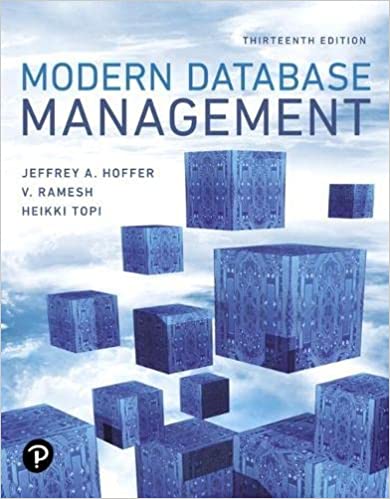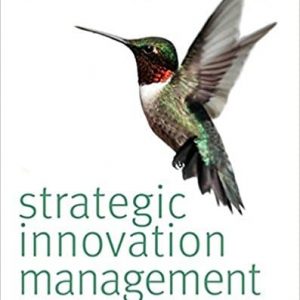No products in the cart.
Management
 Loading...
Loading...
Modern Database Management, 13th Edition Jeffrey A. Hoffer Case study +Instructor’s Manual
Modern Database Management, 13th Edition Jeffrey A. Hoffer Case study +Instructor’s Manual
Database Management
( Case study +Instructor’s Manual)
Modern Database Management, 13th Edition Jeffrey A. Hoffer Case study +Instructor’s Manual
Edition: 13thEdition
Author Name: Jeffrey A. Hoffer
contact:
Whatsapp +1 (949) 734-4773
for the Facebook page click here
for more books for ( Test Bank and Solution Manual) click here
sample free
Chapter 1 The Database Environment and Development Process
 Loading...
Loading...
$39.00 $100.00
Modern Database Management, 13th Edition Jeffrey A. Hoffer Case study +Instructor’s Manual
Database Management
( Case study +Instructor’s Manual)
Modern Database Management, 13th Edition Jeffrey A. Hoffer Case study +Instructor’s Manual
Edition: 13thEdition
Author Name: Jeffrey A. Hoffer
contact:
Whatsapp +1 (949) 734-4773
for the Facebook page click here
for more books for ( Test Bank and Solution Manual) click here
sample free
Chapter 1 The Database Environment and Development Process
Chapter Overview
The purpose of this chapter is to introduce students to the world of data management as a whole, and specifically to the database approach to information systems development, the important concepts and principles of the database approach, and the database development process within the broader context of information systems development. This is an important chapter because it conveys a sense of the central importance of databases and data management in today’s information systems environment and in all modern enterprises. The idea of an organizational database is intuitively appealing to most students. However, many students will have little or no background or experience with the technical implementation of databases. Others will have had some experience with database management systems intended for personal or workgroup use (such as Microsoft Access). Consequently, they will have a limited perspective concerning an organizational approach to databases.
In this chapter, we introduce the basic concepts and definitions of databases and data management, starting with an organizing framework that is new to this chapter. We contrast data with information, and introduce the notion of metadata and its importance. We also contrast the database approach with older file processing systems, and introduce the Pine Valley Furniture Company case to illustrate these concepts. We describe the range of database applications, from databases with a personal or workgroup scope to enterprise databases, and identify key decisions that must be made for each type of database. We describe both the potential benefits and typical costs of using the database approach. We also trace the historical evolution of database systems, in order to provide a context for understanding the database approach for data storage and retrieval. The chapter outlines the differences between transactional and informational approaches and highlights the way new, analytics-focused technologies are transforming data management.
The chapter also presents an expanded description of the systems development life cycle (including an introduction to rapid application development methods of prototyping and agile software development) and the role of database development within it. The chapter provides an updated description of the well-known three-schema architecture and uses it to summarize the various deliverables of database development. It concludes with an example of database development situated in the context the Pine Valley Furniture Company case.
Chapter Objectives
Specific student learning objectives are included at the beginning of each chapter. From an instructor’s point of view, the objectives of this chapter are to:
⦁ Create a sense of excitement concerning the data and database management field and the types of job opportunities that are available.
⦁ Acquaint students with the broad spectrum of database applications and how organizations are using database applications for competitive advantage.
⦁ Introduce the data management framework that organizes the book and the conceptual space of data management, highlighting how relational technologies and non-relational technologies can be seen as part of the same space.
⦁ Introduce the key terms and definitions that describe the database environment.
⦁ Describe data models and how they are used to capture the nature and relationships among data.
⦁ Describe the major components of the database environment and how these components interact with each other.
⦁ Provide a review of systems development methodologies, particularly the systems development life cycle, prototyping, and agile software development; build an understanding of how database development is aligned with these methodologies.
⦁ Develop an understanding of the different roles within in a database development team.
⦁ Make students aware of the three-schema architecture and its benefits for database development and design.
⦁ Introduce the Pine Valley Furniture Company case, which is used throughout the text to illustrate important concepts.
⦁ Introduce the Mountain View Community Hospital case, which is included at the end of each chapter as a source for student projects.
Key Terms
Agile software development Database Metadata
Conceptual schema Database application Physical schema
Constraint Database management system (D B M S) Project
Data Enterprise data modeling Prototyping
Data independence Enterprise resource planning (E R P) Relational database
Data model Entity Repository
Data modeling and design tools Information Systems development life cycle (S D L C)
Data warehouse Logical schema User view
Classroom Ideas
⦁ Start with a discussion of how students interact with systems built on databases on a daily basis (credit card transactions, shopping cards, telephone calls, cell phone contact lists, downloadable music, etc.). If you teach in a classroom with computers, ask students to find examples of Web sites that appear to be accessing databases.
⦁ Contrast the terms “data” and “information.” Using Figure 1-1 as a starting point, have the students provide some good examples of data and information from their own experiences. This may well lead to some differences of opinion, and the conclusion that one person’s data may be another person’s information.
⦁ Introduce the concept of metadata using Table 1-1. Ask the students to suggest other metadata that might be appropriate for this example.
⦁ Discuss file processing systems and their limitations, using Figure 1-2 and Table 1-2. Emphasize that many of these systems are still in use today.
⦁ Introduce data models using Figure 1-3. Discuss the differences between an enterprise data model and a project data model, using Figures 1-3 (a) and (b).
⦁ Discuss each of the advantages of the database approach (Table 1-3). Stress that these advantages can only be achieved through strong organizational planning and commitment. Also discuss the costs and risks of the database approach (Table 1-4).
⦁ Introduce the integrated data management framework presented in Figure 1-5 with a particular focus on the Operational – Informational distinction and the emergence of new technologies (such as No S Q L D B M Ss and Hadoop) in the Analytical–Big Data category.
⦁ Introduce the students to the major components of the database environment (Figure 1-6). Stress the interfaces between these components and the fact that a proper selection of the components can “make or break” a database implementation.
⦁ Introduce the concept of a data warehouse as a type of enterprise database. This topic is described in detail in Chapter 9.
⦁ Review the evolution of database technologies and the significance of each era (Figure 1-11). Add your own perspective to the directions that this field is likely to take in the future.
⦁ Your students may have examples from their workplaces to contribute about client/server architectures. You may also provide them with an understanding of where the D B M S software and their data will be stored at your school as an illustration.
⦁ A quick in-class demo of Microsoft Access or similar product is useful to give the students an initial exposure to a D B M S and demonstrate a prototyping approach to database development. Consider using the P V F C prototyping request as an example.
⦁ If time permits, have the students answer several problems and exercises in class.
⦁ Use the project case to reinforce concepts discussed in class. Students can be assigned to work on this case in class if time permits, or it can be used as a homework assignment.
⦁ If time permits, use Teradata University Network resources to demonstrate the structure and contents of a relational database for some of the textbook data sets. Demonstrate, or lead students through, some simple S Q L retrieval exercises against the textbook databases.
Answers to Review Questions
⦁ Define each of the following key terms:
⦁ Data. Stored representations of objects and events that have meaning and importance in the user’s environment.
⦁ Information. Data that have been processed in such a way as to increase the knowledge of the person who uses it.
⦁ Metadata. Data that describes the properties or characteristics of end-user data and the context of that data.
⦁ Enterprise resource planning (E R P). A class of systems that integrate all functions of the enterprise, such as manufacturing, sales, finance, marketing, inventory, accounting and human resources.
⦁ Data warehouse. An integrated decision support database whose content is derived from the various operational databases.
⦁ Constraint. A rule that cannot be violated by database users.
⦁ Database. An organized collection of logically related data.
⦁ Entity A person, place, object, event, or concept in the user environment about which the organization wishes to maintain data.
⦁ Database management system. A software system that is used to create, maintain, and provide controlled access to user databases.
⦁ Data lake. A large integrated repository for internal and external data that does not follow a predefined schema.
⦁ Systems development life cycle (S D L C). A traditional methodology used to develop, maintain, and replace information systems.
⦁ Prototyping. An iterative process of systems development in which requirements are converted to a working system that is continually revised through close work between analysts and users.
⦁ Enterprise data model. The first step in database development, in which the scope and general contents of organizational databases are specified.
⦁ Conceptual data model. A detailed, technology-independent specification of the overall structure of organizational data.
⦁ Logical data model. The representation of data for a particular data management technology (such as the relational model). In the case of a relational data model, elements include tables, columns, rows, primary and foreign keys, as well as constraints.
⦁ Physical data model. A set of specifications that detail how data from a logical data model (or schema) are stored in a computer’s secondary memory for a specific database management system. There is one physical data model (or schema) for each logical data model.
⦁ Match the following terms and definitions:
c agile software development
b database application
l constraint
g repository
f metadata
m data warehouse
a information
j user view
k database management system
h data independence
e entity
i enterprise resource planning (E R P)
r systems development life cycle (S D L C)
o prototyping
d enterprise data model
q conceptual schema
p internal schema
n external schema
Chapter 1 The Database Environment and Development Process
Chapter Overview
The purpose of this chapter is to introduce students to the world of data management as a whole, and specifically to the database approach to information systems development, the important concepts and principles of the database approach, and the database development process within the broader context of information systems development. This is an important chapter because it conveys a sense of the central importance of databases and data management in today’s information systems environment and in all modern enterprises. The idea of an organizational database is intuitively appealing to most students. However, many students will have little or no background or experience with the technical implementation of databases. Others will have had some experience with database management systems intended for personal or workgroup use (such as Microsoft Access). Consequently, they will have a limited perspective concerning an organizational approach to databases.
In this chapter, we introduce the basic concepts and definitions of databases and data management, starting with an organizing framework that is new to this chapter. We contrast data with information, and introduce the notion of metadata and its importance. We also contrast the database approach with older file processing systems, and introduce the Pine Valley Furniture Company case to illustrate these concepts. We describe the range of database applications, from databases with a personal or workgroup scope to enterprise databases, and identify key decisions that must be made for each type of database. We describe both the potential benefits and typical costs of using the database approach. We also trace the historical evolution of database systems, in order to provide a context for understanding the database approach for data storage and retrieval. The chapter outlines the differences between transactional and informational approaches and highlights the way new, analytics-focused technologies are transforming data management.
The chapter also presents an expanded description of the systems development life cycle (including an introduction to rapid application development methods of prototyping and agile software development) and the role of database development within it. The chapter provides an updated description of the well-known three-schema architecture and uses it to summarize the various deliverables of database development. It concludes with an example of database development situated in the context the Pine Valley Furniture Company case.
Chapter Objectives
Specific student learning objectives are included at the beginning of each chapter. From an instructor’s point of view, the objectives of this chapter are to:
⦁ Create a sense of excitement concerning the data and database management field and the types of job opportunities that are available.
⦁ Acquaint students with the broad spectrum of database applications and how organizations are using database applications for competitive advantage.
⦁ Introduce the data management framework that organizes the book and the conceptual space of data management, highlighting how relational technologies and non-relational technologies can be seen as part of the same space.
⦁ Introduce the key terms and definitions that describe the database environment.
⦁ Describe data models and how they are used to capture the nature and relationships among data.
⦁ Describe the major components of the database environment and how these components interact with each other.
⦁ Provide a review of systems development methodologies, particularly the systems development life cycle, prototyping, and agile software development; build an understanding of how database development is aligned with these methodologies.
⦁ Develop an understanding of the different roles within in a database development team.
⦁ Make students aware of the three-schema architecture and its benefits for database development and design.
⦁ Introduce the Pine Valley Furniture Company case, which is used throughout the text to illustrate important concepts.
⦁ Introduce the Mountain View Community Hospital case, which is included at the end of each chapter as a source for student projects.
Key Terms
Agile software development Database Metadata
Conceptual schema Database application Physical schema
Constraint Database management system (D B M S) Project
Data Enterprise data modeling Prototyping
Data independence Enterprise resource planning (E R P) Relational database
Data model Entity Repository
Data modeling and design tools Information Systems development life cycle (S D L C)
Data warehouse Logical schema User view
Classroom Ideas
⦁ Start with a discussion of how students interact with systems built on databases on a daily basis (credit card transactions, shopping cards, telephone calls, cell phone contact lists, downloadable music, etc.). If you teach in a classroom with computers, ask students to find examples of Web sites that appear to be accessing databases.
⦁ Contrast the terms “data” and “information.” Using Figure 1-1 as a starting point, have the students provide some good examples of data and information from their own experiences. This may well lead to some differences of opinion, and the conclusion that one person’s data may be another person’s information.
⦁ Introduce the concept of metadata using Table 1-1. Ask the students to suggest other metadata that might be appropriate for this example.
⦁ Discuss file processing systems and their limitations, using Figure 1-2 and Table 1-2. Emphasize that many of these systems are still in use today.
⦁ Introduce data models using Figure 1-3. Discuss the differences between an enterprise data model and a project data model, using Figures 1-3 (a) and (b).
⦁ Discuss each of the advantages of the database approach (Table 1-3). Stress that these advantages can only be achieved through strong organizational planning and commitment. Also discuss the costs and risks of the database approach (Table 1-4).
⦁ Introduce the integrated data management framework presented in Figure 1-5 with a particular focus on the Operational – Informational distinction and the emergence of new technologies (such as No S Q L D B M Ss and Hadoop) in the Analytical–Big Data category.
⦁ Introduce the students to the major components of the database environment (Figure 1-6). Stress the interfaces between these components and the fact that a proper selection of the components can “make or break” a database implementation.
⦁ Introduce the concept of a data warehouse as a type of enterprise database. This topic is described in detail in Chapter 9.
⦁ Review the evolution of database technologies and the significance of each era (Figure 1-11). Add your own perspective to the directions that this field is likely to take in the future.
⦁ Your students may have examples from their workplaces to contribute about client/server architectures. You may also provide them with an understanding of where the D B M S software and their data will be stored at your school as an illustration.
⦁ A quick in-class demo of Microsoft Access or similar product is useful to give the students an initial exposure to a D B M S and demonstrate a prototyping approach to database development. Consider using the P V F C prototyping request as an example.
⦁ If time permits, have the students answer several problems and exercises in class.
⦁ Use the project case to reinforce concepts discussed in class. Students can be assigned to work on this case in class if time permits, or it can be used as a homework assignment.
⦁ If time permits, use Teradata University Network resources to demonstrate the structure and contents of a relational database for some of the textbook data sets. Demonstrate, or lead students through, some simple S Q L retrieval exercises against the textbook databases.
Answers to Review Questions
⦁ Define each of the following key terms:
⦁ Data. Stored representations of objects and events that have meaning and importance in the user’s environment.
⦁ Information. Data that have been processed in such a way as to increase the knowledge of the person who uses it.
⦁ Metadata. Data that describes the properties or characteristics of end-user data and the context of that data.
⦁ Enterprise resource planning (E R P). A class of systems that integrate all functions of the enterprise, such as manufacturing, sales, finance, marketing, inventory, accounting and human resources.
⦁ Data warehouse. An integrated decision support database whose content is derived from the various operational databases.
⦁ Constraint. A rule that cannot be violated by database users.
⦁ Database. An organized collection of logically related data.
⦁ Entity A person, place, object, event, or concept in the user environment about which the organization wishes to maintain data.
⦁ Database management system. A software system that is used to create, maintain, and provide controlled access to user databases.
⦁ Data lake. A large integrated repository for internal and external data that does not follow a predefined schema.
⦁ Systems development life cycle (S D L C). A traditional methodology used to develop, maintain, and replace information systems.
⦁ Prototyping. An iterative process of systems development in which requirements are converted to a working system that is continually revised through close work between analysts and users.
⦁ Enterprise data model. The first step in database development, in which the scope and general contents of organizational databases are specified.
⦁ Conceptual data model. A detailed, technology-independent specification of the overall structure of organizational data.
⦁ Logical data model. The representation of data for a particular data management technology (such as the relational model). In the case of a relational data model, elements include tables, columns, rows, primary and foreign keys, as well as constraints.
⦁ Physical data model. A set of specifications that detail how data from a logical data model (or schema) are stored in a computer’s secondary memory for a specific database management system. There is one physical data model (or schema) for each logical data model.
⦁ Match the following terms and definitions:
c agile software development
b database application
l constraint
g repository
f metadata
m data warehouse
a information
j user view
k database management system
h data independence
e entity
i enterprise resource planning (E R P)
r systems development life cycle (S D L C)
o prototyping
d enterprise data model
q conceptual schema
p internal schema
n external schema







There are no reviews yet.